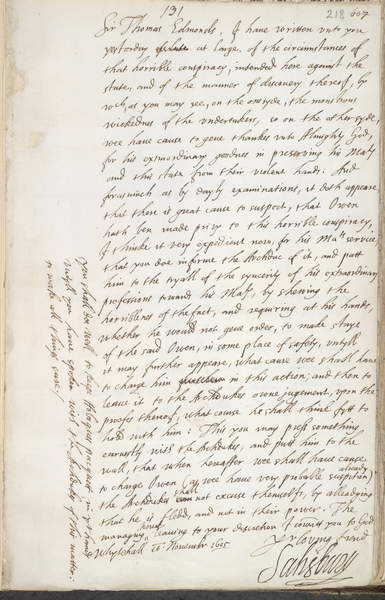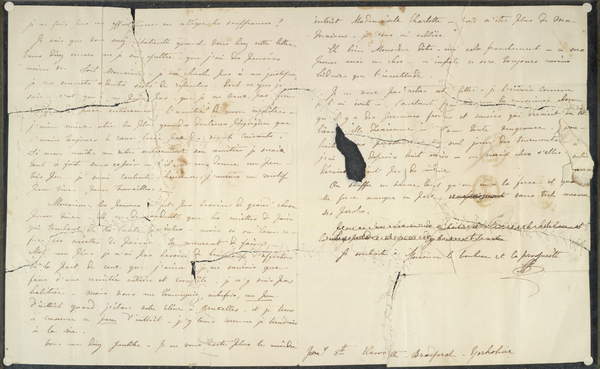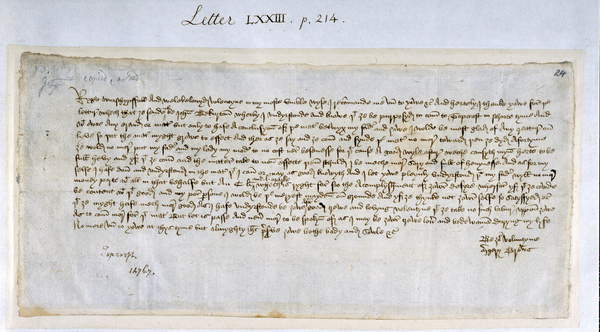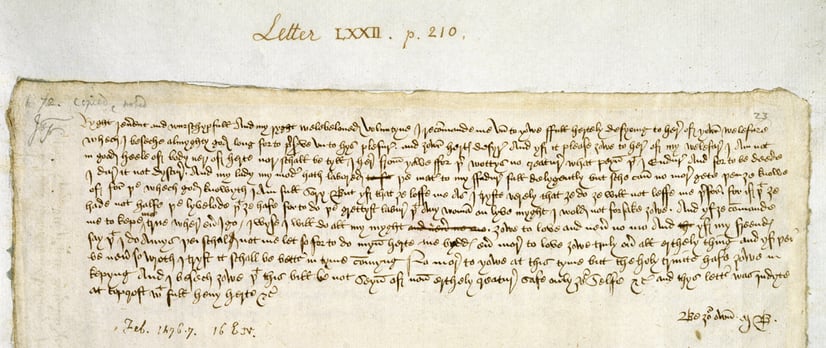The British Library holds an extensive collection of letters reaching back through history. Here we select some of the most astonishing.

1. A letter recognising Henry VIII. as supreme head of the Church of England; 23 Oct. 1535. Lat . With signatures. / British Library, London, UK / © British Library Board. All Rights Reserved / Bridgeman Images
The British Library has an extensive collection of correspondence surrounding Henry VIII . These extraordinary documents range from secretive letters between the king and his advisors, emotional messages between Lady Jane Grey and her sister during her incarceration, to formal, world-changing documents such as the letter recognising Henry VIII as the head of the Church of England. The consequences of Henry VIII’s creation of the Protestant church are innumerable, and the preservation and current existence of this document which changed the world we live in is astounding.
Other letters from this era are emotive in their portrayal of the hopes and fears of the people living at the time. The letter Henry VIII sent to Cardinal Wolsey in June 1518 excitably suggesting Catherine of Aragon’s pregnancy is heart breaking when she gave birth to a still born girl five months later. Henry’s frustration at the lack of male heir produced by Catherine was partly the reason for their separation and the creation of Protestantism – the consequences of moments in history are easy to follow with these resources. The announcement of Anne Boleyn and Henry VIII’s first child reveals that they had been prepared for a prince, hastily adding an ‘s’ to the word when Elizabeth was born. Finally the long-awaited announcement of Jane Seymour’s son, Edward, is also kept in the British Library.
Ada Lovelace (1815-1852) to Charles Babbage (1791-1871)

This letter from Ada Lovelave to Charles Babbage proposes an example of a calculation that ‘may be worked out by the engine without having been worked out by human head and hands first’. It is the first time that the principle of the computer program had been set out in writing. / British Library, London, UK / © British Library Board. All Rights Reserved / Bridgeman Images
Ada Lovelace here writes to Charles Babbage about her idea, a machine that can complete tasks a person can’t or in her words: a calculation that ‘may be worked out by the engine without having been worked out by human head and hands first.’ Essentially this letter records the invention of programming, without which you could not be reading this article. Described by Babbage as the ‘enchantress of numbers’, Lovelace (the poet Lord Byron’s daughter) and her ideas were critical to Alan Turing’s creation of the modern computer, and life as we know it today. It is strange to think that someone involved in the creation of a computer, leading on to smart phones, iPads, AI, even self-driven cars, was a 19th century Countess, a contemporary and friend of Charles Dickens.
Charles Dickens (1812-1870) to Catherine Hogarth (1815-1879)

Letter from Charles Dickens to Catherine Hogarth, May 1835. / British Library, London, UK / © British Library Board. All Rights Reserved / Bridgeman Images
The personal lives of any creative feeds directly into their art and yet often the viewer, reader or listener must try to infer what they can about the situation, only able to guess the identity of the muse, the inspiration behind the idea. With Charles Dickens however you need only read his letters. The British library have 136 letters written between Charles Dickens and his wife, Catherine Hogarth, covering their courtship, married life and separation. Having met in 1834, become engaged in 1835, married in 1836 and then separated in 1858, their tumultuous relationship and the 10 children it produced can explain how Dickens created so many characters, and so many complex relationships; his own went through every stage imaginable. Upon his and Hogarth’s legal separation in June 1858 Dickens published a notice in the London Times, stating that
“Some domestic trouble of mine, of long-standing, on which I will make no further remark than that it claims to be respected, as being of a sacredly private nature, has lately been brought to an arrangement, which involves no anger or ill-will of any kind, and the whole origin, progress, and surrounding circumstances of which have been, throughout, within the knowledge of my children. It is amicably composed, and its details have now to be forgotten by those concerned in it.’
Is this the 19th century version of ‘consciously uncoupling?’
Italian London Fascists to Sylvia Pankhurst (1882-1960)

‘Madame Pankhurst…’, ‘New Times and Ethiopia News’, 7 September 1940 (print) / British Library, London, UK / Bridgeman Images
Sylvia Pankhurst, the estranged daughter of Emmeline Pankhurst, received this message on 7 September 1940 after campaigning for Ethiopia following its invasion by Italy in 1935. The threat is terrifying; imagine receiving a letter with the line ‘Hitler knows your address’.
A seasoned suffragette, after being arrested and participating in hunger strikes many times, Pankhurst was expelled from the WSPU by her mother after advertising/disclosing her socialist outlook by trying to get working class women the vote. This did not stop her campaigning, now working with the East London Federation. Her socialist political beliefs meant she understood the potential danger of extreme fascists, such as Mussolini and Hitler, from early on. In 1935 she devoted herself to campaigning for Ethiopia, eventually moving there and becoming a close friend and advisor to Hailie Selassie. Upon her death she was given a full state funeral, and named by Selassie as an ‘honorary Ethiopian’.
Robert Cecil (1563-1612) to Archduke Albert

The Gunpowder Plot / British Library, London, UK / © British Library Board. All Rights Reserved / Bridgeman Images
This letter was written by Robert Cecil, Earl of Salisbury, upon his discovery of the gunpowder plot, instructing the Archduke Albert to arrest Owen, a suspected conspirator in the plot. The British Library also has Cecil’s full account of the plot, which had been sent with the warning Lord Monteagle (brother-in-law to one of the conspirators) received on the 26th October 1805. This warning was immediately passed to Cecil, resulting in the investigation and foiling of the plot. If it had not been discovered, or if Monteagle or Cecil had acted differently we could be remembering 5th November in a completely different context. This letter is quite contentious, as some question whether Cecil himself was behind the plot, organising and then ‘discovering’ it at the last minute in order to convince James I that Catholics were a serious threat to his rule.
Esther van Homrigh (1690-1723) to Jonathan Swift (1667-1745)

Letter from Vanessa [Esther Van Homrigh] to Jonathan Swift. Extract from letter: ‘I could have bore the rack much better than those killing, killing words of yours’. / British Library, London, UK / © British Library Board. All Rights Reserved / Bridgeman Images
Charlotte Bronte (1816-1855) to Prof. Constantin Heger

Letters from Charlotte Bronte to Prof. Constantin Heger, 1844-45 (ink on paper), Bronte, Charlotte (1816-55) / British Library, London, UK / © British Library Board. All Rights Reserved / Bridgeman Images
If you have read Villette, Charlotte Bronte’s first novel, this letter will appear to have jumped out of the pages. The novel is about a young student who fell in love with her professor, exactly as Charlotte Bronte did when studying in Belgium, falling for Professor Constantin Heger. The letters she sent to her professor shocked him deeply; he was happily married to his second wife, his first wife and son dying of cholera a decade before he met Bronte. On receiving the letters he apparently immediately tore them up and threw them away. His wife then retrieved the letters, neatly sewed them together and preserved them. Why did Parent do this? She claimed she did so to prove that the relationship was one sided, that Heger never replied and threw the letters away immediately. The neat folds and worn paper however could have come from preservation before or after the were ripped up, and Heger may have responded – we may never know. He was immortalised however by Bronte, as the professor in Villette as well as an inspiration for Mr Rochester in Jane Eyre.
Margery Brews to John Paston III

[Whole folio] Valentine letter from Margery Brews to John Paston III, February 1477 / British Library, London, UK / © British Library Board. All Rights Reserved / Bridgeman Images
Alcuin (c. 735-804) to Higbald

Cotton Vespasian A. XIV, f.126v Letter of Alcuin offering commiserations on the Viking attack on Lindisfarne in 793 (ink on vellum), English School, (11th century) / British Library, London, UK / © British Library Board. All Rights Reserved / Bridgeman Images
Alcuin was one of Charlemagne the Great’s (c. 742-814) most trusted advisers and a key instigator of the Carolingian Renaissance, a period of interest in art and education. A prolific writer and well respected scholar, he is used as a key source for the this time period. Some medieval historians do not completely trust Carolingian records; while the copied and translated many records stretching back to the Roman empire which otherwise would have been lost, it must also be kept in mind that ‘history is written by the victors’ (Churchill). This letter provides an unbiased insight into religious beliefs of the period as well as an accurate date for the first Viking raid on Britain. Alcuin writes to the king of Northumbria, offering condolences for the brutal Viking attack on Lindisfarne, Northumbria in 793, the first king. He also, rather tactlessly by today’s standards suggests the inhabitants of Lindisfarne brought this punishment from God upon themselves through participating in non-Christian behaviour.
Lord Arthur Balfour (1848-1930) to Lord Rothschild

The Balfour Declaration / British Library, London, UK / © British Library Board. All Rights Reserved / Bridgeman Images
The Balfour Declaration is the piece of legislation which sparked the Israel-Palestine Conflict, an issue still as difficult and unsettled as when Lord Arthur Balfour, the foreign secretary at the time, signed the declaration in 1917. Did Balfour truly believe that a safe place for both communities could be created without ‘prejudic[ing] the civil and religious rights of existing non-Jewish communities in Palestine’? Whatever your thoughts on the matter, it is absolutely fascinating to see the piece of paper which changed the lives of so many in such an extreme way.
These letters reach us and affect us even today. They provide a record of decisions and actions taken, an understanding of our own history and a documentation of the personal lives of those whose personalities and words could have been lost in history.
Alongside these letters, the British Library have thousands of papers and documents concerning every period and person imaginable. There are letters to and from Michelangelo, Oliver Cromwell, Florence Nightingale and Mozart. The British Library holds the diaries of Robert Falcon Scott, the letter in which Darwin first sets out his ideas concerning evolution, next to the despatch recording the victory at Waterloo, beside correspondence detailing the discovery of mineral and oil deposits in Kuwait territory. They are all accessible in the Library’s Reading Rooms, with an index online.
Discover More


